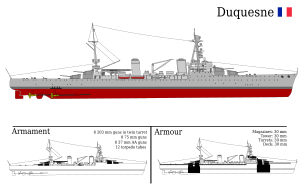
Back Тежки крайцери тип „Дюкен“ Bulgarian Třída Duquesne Czech Duquesne-Klasse (1929) German ناو کلاس داکسن Persian Duquesne-luokka Finnish Classe Duquesne (croiseur) French Classe Duquesne (incrociatore) Italian デュケーヌ級重巡洋艦 Japanese Krążowniki ciężkie typu Duquesne Polish Classe Duquesne Portuguese
 Duquesne in her 1939 configuration
| |
| Class overview | |
|---|---|
| Name | Duquesne class |
| Operators | French Navy |
| Succeeded by | Suffren class |
| Built | 1924–1928 |
| In service | 1929–1962 |
| Building | 2 |
| Completed | 2 |
| Retired | 2 |
| General characteristics | |
| Type |
|
| Displacement | |
| Length |
|
| Beam | 19 m (62 ft 4 in) |
| Draught | 6.32 m (20 ft 9 in) |
| Propulsion |
|
| Speed | 34 knots (63 km/h) (designed) |
| Range |
|
| Complement | 605 |
| Armament |
|
| Armour |
|
| Aircraft carried | 2 FBA 17 and CAMS 37A (superseded by GL-810 then Loire-Nieuport 130 |
| Aviation facilities | 1 catapult |
The Duquesne-class cruiser was a group of two heavy cruisers built for the French Navy in the mid 1920s, the first such vessels built for the French fleet. The two ships in the class were the Duquesne and Tourville.
With the ratification of the Washington Naval Treaty of 1922, France could not ignore the ramifications of the cruiser article. To maintain her position of a major naval power she would have to follow the other four major naval powers with her own 10,000-ton, 8-inch gun cruiser.[2] The only modern cruiser design Service techniques des constructions navales (STNC - Constructor's Department)[3] had to draw on was the recently designed 8,000-ton Duguay-Trouin-class design. The cruiser design authorized under the 1924 build program would sacrifice protection for speed while maintaining the 10,000-ton displacement restriction while mounting 8 inch guns.[4] Two vessels would be authorized and would be known as the Duquesne-class cruiser.
Initially classed as a light cruiser, both ships were reclassified on 1 July 1931 as first class cruisers. The French Navy did not have a vessel classification of heavy cruiser instead used armoured cruiser and light cruiser prior to the London Naval Treaty then first class cruiser and second class cruiser afterwards.[5]
© MMXXIII Rich X Search. We shall prevail. All rights reserved. Rich X Search